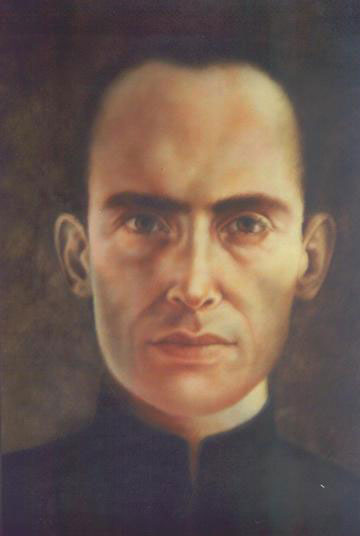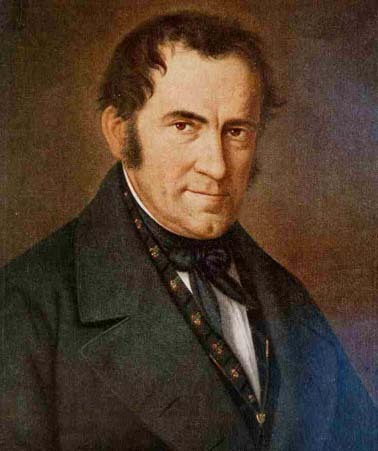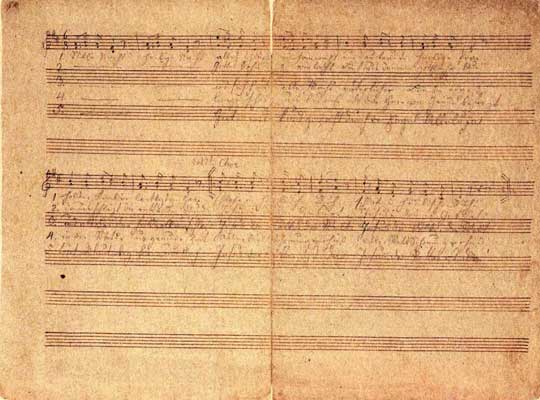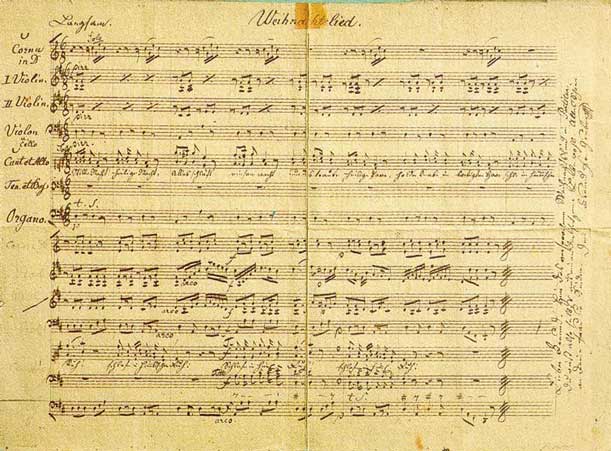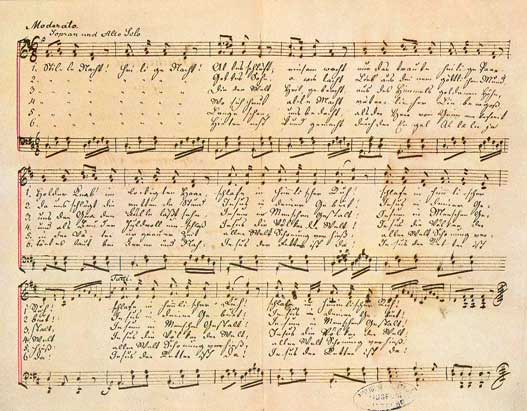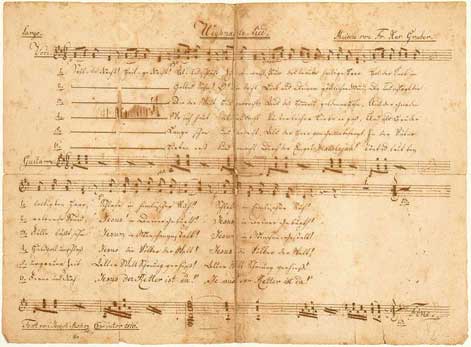Joseph Mohr (left) and Franz Gruber: Mohr’s text and Gruber’s melody formed one of the best-known Christmas carols in history. It was first performed on Christmas, 1818, at St. Nicholas Church, in Oberndorf, Austria, on land now occupied by the Silent Night Memorial Chapel (see photo inset below).‘Silent Night!’ From The Hands Of The Creators
Given recent findings, historians know that Joseph Mohr created the text to “Silent Night” in the form of a poem in 1816 while serving in Mariapfarr in the Lungau region of the province of Salzburg. Two years later, Franz Xaver Gruber added the melody to the lyrics. During the years 1815-1817, Mohr held the position of assistant priest in Mariapfarr. The house of his grandfather, called the “Scharglerkeusche,” is located at Stranach Nr. 21 not far from Mariapfarr. A reference to Mohr can also be found as part of a relief sculpture in the town’s war memorial monument (World War I, 1914-1918).
On the occasion of Christmas, 1818, Gruber and Mohr performed “Silent Night! Holy Night!” for the first time in the St. Nicholas church. Gruber served as organist for the Oberndorf church from 1816-1829, while Mohr was assistant priest (1817-1819). This church was torn down around the turn of the century, and on its site now stands the Silent Night Memorial Chapel. The chapel, a memorial plaque on the caretaker’s house where Mohr lived, and a monument in front of the new parish church recognize the events of 1818.
“Silent Night” TIMELINE
1816: Joseph Mohr creates the text to "Silent Night!" in the form of a poem in Mariapfarr in the Lungau region where he was living at the time.
1818: In the schoolhouse of Arnsdorf, on Christmas Eve, Franz Xaver Gruber composes a melody to fit the text.
1818: "Silent Night! Holy Night!" has its world premiere on Christmas Eve in the St. Nicholas church of Oberndorf near Salzburg, performed by Franz Xaver Gruber and Joseph Mohr.
Historical Context
"Silent Night!" was created and first performed during very difficult times. The Napoleonic wars (1792-1815), which had caused great suffering, had come to an end. With the Congress of Vienna there were new borders and a new order set for Europe. In the course of these events, the ecclesiastical Principality of Salzburg lost its status as an independent country and was forced to secularize. In 1816, its lands were divided in two with part assigned to Bavaria and the larger portion relegated to Austria. The site where "Silent Night!" was first performed—Oberndorf by Salzburg—had been a suburb and was now separated from its town center of Laufen located across the river (today part of Bavaria, Germany) when the Salzach River became the new border. For centuries transportation of salt along the river had provided the basis for the local economy. The salt trade declined during the Napoleonic wars, and then never fully recovered. This caused a depression in the local economy, with the transport companies, boat builders and laborers facing unemployment and an unsure future. It was during these troubled times that Mohr was in Oberndorf (1817-1819).
Mohr's previous place of service, Mariapfarr, had suffered greatly during the withdrawal of the Bavarian occupation troops in 1816 and 1817. Mohr was witness to these events and in 1816, he wrote the words to "Silent Night!" With this in mind, the creation of the fourth verse of "Silent Night!" takes on special meaning. Its text expresses a great longing for peace and comfort.
Including the original autographed score from the hand of Franz Gruber, a total of eight autographed versions of the song from the hands of the creators are known to exist. The following are brief descriptions and images of four of these.
FRANZ GRUBER-AUTOGRAPH II
Undated 'Silent Night' score by Franz Gruber, estimated to be from around 1854; D-Dur, 6/8 time; for two solo voices and choir, without accompaniment; five verses (the third verse of the original is missing). Location: Silent Night Archives, Hallein.
FRANZ GRUBER-AUTOGRAPH V
Undated score by Franz Gruber, estimated to be from around 1845; with title: "Weihnachtslied" ("Christmas Carol"); D-Dur, 6/8 time; for two solo voices with mixed choir and accompaniment by a stringed trio, two horns and organ; one verse of text (verse one of original). Location: Silent Night Archives, Hallein.
FRANZ GRUBER-AUTOGRAPH VII
Undated score by Franz Gruber, estimated to be from around 1860; with title: "Kirchenlied/auf die/heilige Christnacht" ("Hymn for the Holy Christmas Eve"); D-dur, 6/8 time; for soprano and alto voices with "quiet organ accompaniment;" six verses. Location: Salzburg Museum, Salzburg.
JOSEPH MOHR-AUTOGRAPH
Undated score by Joseph Mohr, estimated to have been written between 1820 and 1825; with title: "Weynachts=Lied" ("Christmas Carol"); D-dur, 6/8 time; for two voices with guitar accompaniment; six verses. Location: Salzburg Museum, Salzburg. Autographed version from Joseph Mohr, Salzburg MuseumWith Gratitude, to the Silent Night Association
Many thanks to the dedicated men and women of Austria’s Silent Night Association, a non-profit organization open to all interested people around the world. The purpose of the Society is to further the research into all aspects of the history surround the Christmas carol “Silent Night! Holy Night!” as well as to promote the awareness and use of authentic versions of the song.Of the multitude of people around the world who enjoy singing “Silent Night” on Christmas Eve, very few are aware of the circumstances concerning the song’s origin, or even that its journey into the world began in Austria, in a town located just north of Salzburg. The Silent Night Association would like to change that by providing a source of information for individuals and media alike.
At its website, the Silent Night Association offers the most important and fundamental information regarding “Silent Night! Holy Night!” The Association serves as the primary source and contact for all questions concerning the song (research, museums, monuments, tourist offerings, and media information).
Visit the Silent Night Association (Stille Nacht Gesellschaft) www.stillenacht.at/en/silent_night.asp
‘Silent Night,’ by Johnny Cash, his daughters and stepdaughters, 1978, their first Christmas without Mother Maybelle Carter, who died on October 23 of that year.
Founder/Publisher/Editor: David McGee
Contributing Editors: Billy Altman, Laura Fissinger, Christopher Hill, Derk Richardson
Logo Design: John Mendelsohn (www.johnmendelsohn.com)
Website Design: Kieran McGee (www.kieranmcgee.com)
Staff Photographers: Audrey Harrod (Louisville, KY; www.flickr.com/audreyharrod), Alicia Zappier (New York)
E-mail: thebluegrassspecial@gmail.com
Mailing Address: David McGee, 201 W. 85 St.—5B, New York, NY 10024


